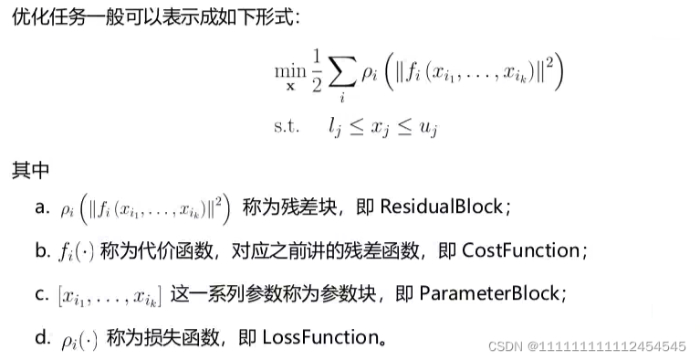简介:
Ceres是谷歌开发的广泛使用的最小二乘问题求解库。用户只需要按照一定的步骤定义待解的优化问题然后交给求解器计算。最小二乘问题一般格式如下:
使用Ceres求解非线性优化问题,一共分为三个部分:
1、 第一部分:构建cost fuction,即代价函数,也就是寻优的目标式。这个部分需要使用仿函数(functor)这一技巧来实现,做法是定义一个cost function的结构体,在结构体内重载()运算符,具体实现方法后续介绍。
2、 第二部分:通过代价函数构建待求解的优化问题。
3、 第三部分:配置求解器参数并求解问题,这个步骤就是设置方程怎么求解、求解过程是否输出等,然后调用一下Solve方法。
简单使用HelloWord(自动求导)
第一部分:构建cost fuction,即代价函数
也就是寻优的目标式。这个部分需要使用仿函数(functor)这一技巧来实现,做法是定义一个cost function的结构体,在结构体内重载()运算符,具体实现方法后续介绍
假设代价函数为![]()
仿函数参考:
C++ 仿函数_Dablelv的博客专栏-CSDN博客_c++仿函数
//第一部分:构建代价函数,重载()符号,仿函数的小技巧
struct CostFunctor {
template <typename T>
bool operator()(const T* const x, T* residual) const {
residual[0] = T(10.0) - x[0];
return true;
}
};
第二部分:通过代价函数构建待求解的优化问题。
// 第二部分:构建寻优问题
Problem problem;
CostFunction* cost_function =
new AutoDiffCostFunction<CostFunctor, 1, 1>(new CostFunctor); //使用自动求导,将之前的代价函数结构体传入,第一个1是输出维度,即残差的维度,第二个1是输入维度,即待寻优参数x的维度。
problem.AddResidualBlock(cost_function, NULL, &x); //向问题中添加误差项,本问题比较简单,添加一个就行。
new AutoDiffCostFunction<CostFunctor, 1, 1>(new CostFunctor)//使用自动求导方式
![]()
第一个参数1:代价函数的维度,在本例中为1,第二个参数为参数块的维度本例中只有一个x也为1。分别对应之前结构体中的residual和x。
将第一部分创建的代价函数CostFunctor传入到此处AutoDiffCostFunction
优化过程中,求导方式有三种分别为,自动求导,数值求导,解析求导。
第三部分:配置求解器参数并求解问题
Solver::Options options;
options.linear_solver_type = ceres::DENSE_QR;
options.minimizer_progress_to_stdout = true;
Solver::Summary summary;
Solve(options, &problem, &summary);
std::cout << summary.BriefReport() << "\n";
std::cout << "x : " << initial_x
<< " -> " << x << "\n";
这一部分很好理解,创建一个Option,配置一下求解器的配置,创建一个Summary。最后调用Solve方法,求解。
结果
iter cost cost_change |gradient| |step| tr_ratio tr_radius ls_iter iter_time total_time
0 4.512500e+01 0.00e+00 9.50e+00 0.00e+00 0.00e+00 1.00e+04 0 5.33e-04 3.46e-03
1 4.511598e-07 4.51e+01 9.50e-04 9.50e+00 1.00e+00 3.00e+04 1 5.00e-04 4.05e-03
2 5.012552e-16 4.51e-07 3.17e-08 9.50e-04 1.00e+00 9.00e+04 1 1.60e-05 4.09e-03
Ceres Solver Report: Iterations: 2, Initial cost: 4.512500e+01, Final cost: 5.012552e-16, Termination: CONVERGENCE
x : 0.5 -> 10
完整代码
#include<iostream>
#include<ceres/ceres.h>
using namespace std;
using namespace ceres;
//第一部分:构建代价函数,重载()符号,仿函数的小技巧
struct CostFunctor {
template <typename T>
bool operator()(const T* const x, T* residual) const {
residual[0] = T(10.0) - x[0];
return true;
}
};
//主函数
int main(int argc, char** argv) {
google::InitGoogleLogging(argv[0]);
// 寻优参数x的初始值,为5
double initial_x = 5.0;
double x = initial_x;
// 第二部分:构建寻优问题
Problem problem;
CostFunction* cost_function =
new AutoDiffCostFunction<CostFunctor, 1, 1>(new CostFunctor); //使用自动求导,将之前的代价函数结构体传入,第一个1是输出维度,即残差的维度,第二个1是输入维度,即待寻优参数x的维度。
problem.AddResidualBlock(cost_function, NULL, &x); //向问题中添加误差项,本问题比较简单,添加一个就行。
//第三部分: 配置并运行求解器
Solver::Options options;
options.linear_solver_type = ceres::DENSE_QR; //配置增量方程的解法
options.minimizer_progress_to_stdout = true;//输出到cout
Solver::Summary summary;//优化信息
Solve(options, &problem, &summary);//求解!!!
std::cout << summary.BriefReport() << "\n";//输出优化的简要信息
//最终结果
std::cout << "x : " << initial_x
<< " -> " << x << "\n";
return 0;
}
解析求导
解析求导即我们自己输入雅克比矩阵,不再使用优化库的自动求导方式,速度上会比自动求导的方式快一些。
形式上稍有不同
第一部分,定义残差函数,并声明雅可比矩阵
class CostFunctor : public ceres::SizedCostFunction<1, 1> {
public:
virtual ~CostFunctor() {}
virtual bool Evaluate(double const* const* parameters,
double* residuals,
double** jacobians) const {
double x = parameters[0][0];
// f(x) = 10 - x.
residuals[0] = 10 - x;
if (jacobians != NULL && jacobians[0] != NULL) {
jacobians[0][0] = -1;
}
return true;
}
};
第二部分:构建求解优化问题
Problem problem;
// CostFunction* cost_function =
// new AutoDiffCostFunction<CostFunctor, 1, 1>(new CostFunctor); //使用自动求导,将之前的代价函数结构体传入,第一个1是输出维度,即残差的维度,第二个1是输入维度,即待寻优参数x的维度。
ceres::CostFunction *cost_function = new CostFunctor;
problem.AddResidualBlock(cost_function, NULL, &x); //向问题中添加误差项,本问题比较简单,添加一个就行。
只有在声明优化函数时与自动求导稍有不同,因为已经知道了雅可比,所以直接创建优化对象即可。
第三部分与解析求导相同
完整代码
/*
* @Author: dushibiao
* @Date: 2022-01-25 15:34:09
* @LastEditTime: 2022-01-25 17:42:01
* @LastEditors: Please set LastEditors
* @Description: 打开koroFileHeader查看配置 进行设置: https://github.com/OBKoro1/koro1FileHeader/wiki/%E9%85%8D%E7%BD%AE
* @FilePath: /ceres/hello_jiexi.cpp
*/
#include<iostream>
#include<ceres/ceres.h>
using namespace std;
using namespace ceres;
class CostFunctor : public ceres::SizedCostFunction<1, 1> {
public:
virtual ~CostFunctor() {}
virtual bool Evaluate(double const* const* parameters,
double* residuals,
double** jacobians) const {
double x = parameters[0][0];
// f(x) = 10 - x.
residuals[0] = 10 - x;
if (jacobians != NULL && jacobians[0] != NULL) {
jacobians[0][0] = -1;
}
return true;
}
};
//主函数
int main(int argc, char** argv) {
google::InitGoogleLogging(argv[0]);
// 寻优参数x的初始值,为5
double initial_x = 5.0;
double x = initial_x;
// 第二部分:构建寻优问题
Problem problem;
// CostFunction* cost_function =
// new AutoDiffCostFunction<CostFunctor, 1, 1>(new CostFunctor); //使用自动求导,将之前的代价函数结构体传入,第一个1是输出维度,即残差的维度,第二个1是输入维度,即待寻优参数x的维度。
ceres::CostFunction *cost_function = new CostFunctor;
problem.AddResidualBlock(cost_function, NULL, &x); //向问题中添加误差项,本问题比较简单,添加一个就行。
//第三部分: 配置并运行求解器
Solver::Options options;
options.linear_solver_type = ceres::DENSE_QR; //配置增量方程的解法
options.minimizer_progress_to_stdout = true;//输出到cout
Solver::Summary summary;//优化信息
Solve(options, &problem, &summary);//求解!!!
std::cout << summary.BriefReport() << "\n";//输出优化的简要信息
//最终结果
std::cout << "x : " << initial_x
<< " -> " << x << "\n";
return 0;
}
CMakeLists
cmake_minimum_required(VERSION 2.8)
project(ceres)
find_package(Ceres REQUIRED)
include_directories(${CERES_INCLUDE_DIRS})
add_executable(use_ceres helloword.cpp)
target_link_libraries(use_ceres ${CERES_LIBRARIES})
add_executable(jiexi hello_jiexi.cpp)
target_link_libraries(jiexi ${CERES_LIBRARIES})
参考
深蓝学院多传感器融合第三节课件
slam十四讲
C++ 仿函数_Dablelv的博客专栏-CSDN博客_c++仿函数
一文助你Ceres 入门——Ceres Solver新手向全攻略_福尔摩睿的工作站-CSDN博客_ceres solver






评论(0)
您还未登录,请登录后发表或查看评论